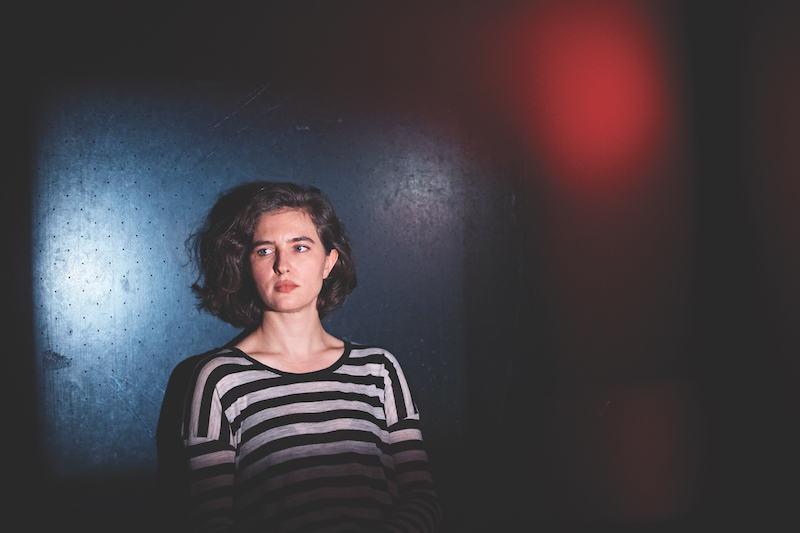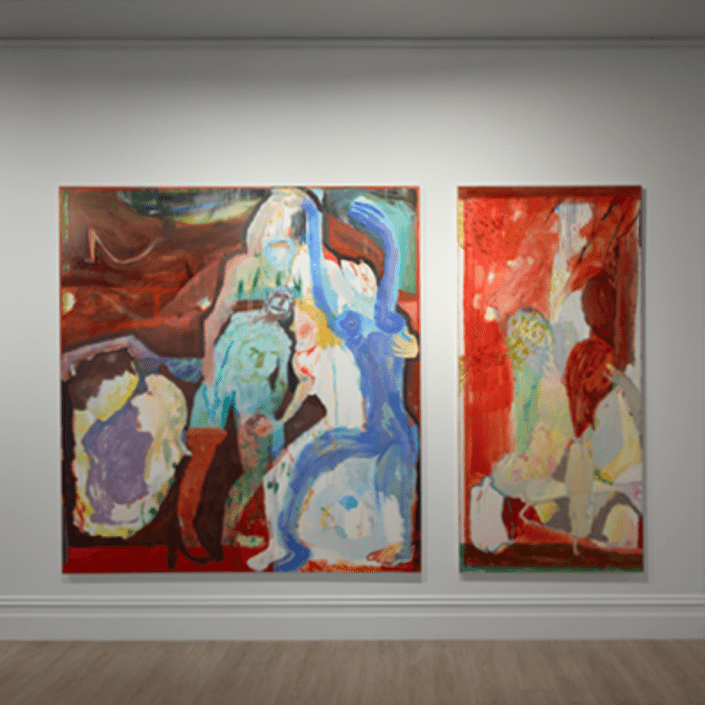Justine Varga: Camera Observa
A photographer without a camera, Justine Varga opens up the conceptual and material possibilities of what a picture can be.
Words: Carrie Miller
Photography: Nick De Lorenzo
THE ORIGINAL IDEA for Justine Varga’s 2016 work Ripe was to expose a sheet of photographic negative to the changing seasons through the conscious placement of it up a tree in her front yard in Wellington, New Zealand. She would wait for the natural elements to literally weather the material and return in Autumn to retrieve it, creating a work inflected with the fragile memory of the temporal nature of things. This deliberate plan seemed to go to waste, however, when a child playing outside snatched the unprocessed film from the tree and brought it inside. Varga’s first thought was that the work had been ruined. But when she examined the material she was struck by its appearance: it had blushed a peachy pink colour, its surface bruised like a piece of fruit. It was ripe and ready to be picked; it was exactly what it needed to be.
The intellectual rigour of Varga’s work is often emphasised in descriptions of the artist and her practice. But while there is a fierce intelligence behind it, the work’s rich materiality is never diminished by an overbearing conceptual rigidity. Along with the film itself, Varga uses “a fairly limited amount of prosaic and abject materials in the production of my photo- graphs, coupled with various darkroom processes”, she says. The film is variously drawn on, handled, scratched, carried around, cried on and spat on by the artist over an extended period of time and then is physically manipulated in multiple ways to arrive at the final print.
Evident in the unintended and unexpected process by which Ripe was realised is Varga’s intuitive feeling for what a work is rather than what it ought to be. While she may begin with an idea, she is acutely aware that “the material obeys its own rules and refuses to be controlled from the beginning”. Varga describes her recent series of work as “diaristic in nature”, “recording aspects of my own life, experience and locations I inhabit”. But it ultimately has a life of its own, an existence excessive to any deliberate or incidental mark-making.
When she won the Olive Cotton Award with her work Maternal Line, which involved her grandmother scribbling with pens and rubbing her saliva on the negative, reactionaries fell over themselves in the rush to deny the legitimacy of her work as photographic portraiture. As one put it: “You have to contribute original expression to the artistic work to be an author.” The manufactured outrage that ensued was driven by old anxieties about the death of the modernist fantasy that there is an original author behind the work of art whose individual (read: male) genius alone creates it. It was also bound up with fears about a (female) artist’s practice that dares to uncouple photography from the conventional constraints of the camera.
For the artist and her many critical admirers, this uncoupling is an act of artistic liberation – it opens up the conceptual and material possibilities of what a photograph and photography can be. As she puts it: “I’m continually pushing at the edges of what undoubtedly is the most ubiquitous medium of our time. I find that the further I go in a certain direction, the greater the expanse of possibilities that opens before me. I believe this is due to my conceptual approach to photography, seeing it not only as a set of processes and materials, but also as an idea with very particular social and political functions … At the core of my endeavour is an effort to unpack the function of the photograph and what it means within a contemporary context.”
The overwrought reaction to Maternal Line exposed more than the banality of literal-minded thinking about what constitutes a work of art. It served to even more plainly reveal the critical significance of Varga’s work in the contemporary art canon. Varga’s originality lies not only in her remarkable ability to produce exceptional photographic works without a camera, it’s in the way these works manage to inhabit that dynamic aesthetic and visual space where the conceptual and material aspects of the artwork temporarily reconcile – a place where great work often resides.
Since graduating in 2007 with an Honours degree in Photography from the National Art School in Sydney, Varga’s professional career has been distinguished by critical acclaim and its attendant awards. In addition to the Olive Cotton prize, the artist has twice received the Josephine Ulrick & Win Schubert Photography Award, the ACME International Residency Programme, London, the Museum of Contemporary Art Australia Primavera Veolia Acquisitive Prize, an Australia Council for the Arts London Studio Residency and, most recently, the Dobell Drawing Prize.
In 2019, she has been shortlisted for the Higashikawa International Photography Award in Japan and her photographs are on display in Defining Space/Place: Australian Contemporary Photography at the Museum of Photographic Arts in San Diego. Her recent series Areola will be exhibited at City Gallery Wellington from November 2018 to March 2020 and a major commission for Duo Central Park in Sydney – a new building designed by Foster + Partners in London – will be unveiled later this year.
Varga is represented by Hugo Michell Gallery in Adelaide and was recently picked up by Melbourne’s Tolarno Galleries. Her work is currently on show at Auckland’s Two Rooms, as part of the 2019 Auckland Festival of Photography.
At a time when there is so much white noise around contemporary art, exemplified by inane social media chatter about what’s in and who’s hot, Varga’s natural strength as an artist and a person lies in her capacity to stand back and observe – to be a sceptical but not indifferent witness to the world around her. In the same way, while she can speak with forceful erudition about her work, she is confident enough to allow its quiet potency to speak for itself.
MARY-LOUISE BROWNE
Gallery Manager, Two Rooms, Auckland
“The Two Rooms team first saw Justine Varga’s work in the land- mark exhibition, Emanations, curated by Geoffrey Batchen at Govett- Brewster Art Gallery in New Plymouth [New Zealand] in 2016. We were then further exposed to her work at the 2017 Sydney Contemporary as part of Hugo Michell Gallery’s booth. The Two Rooms booth was directly opposite, so we were able to view her extraordinary photo- graphs in-situ for five days and became captivated with her process.
“The series in the latest exhibition presented at Two Rooms, Memoire, evolved over a period of time and was originally exhibited at Hugo Michell Gallery in Adelaide in 2016 and again in a group exhibition, Silver and Salt, at Hazelhurst Regional Gallery, New South Wales in 2016–17. The series reflects the continuity of her practice, which
is derived from the particularities of her location in or movement between Australia, New Zealand and Europe. Varga describes the exhibition as ‘photographs that speak of displacement, negotiating a transaction between localities rather than offering a static celebration of origins’.
“Our New Zealand audience might be interested to know that most of the exposures were made in New Zealand, specifically Ripe, Abrasion, Venom, Antidote and Cerebration. For instance, Abrasion was left to record the rolling Wellington mist however things turn nasty out there. The mistreatment of the negative is evidenced through the scarring of the prints chromatic surface. Similarly, Venom was left out in the Wellington weather over a period of two months, to suffer the consequences.”
SHAUN LAKIN
Senior Curator of Photography, National Gallery of Australia, Canberra
“Justine Varga is too articulate and considered to have other people represent her processes. I can’t really talk about how she somehow elicits complex but hitherto unseen images out of pieces of 5 by 4 negative subjected to processes of (often entirely prosaic) inscription over which she often has very little control: pushing emulsion around with substances; walking around with or carrying for days on end strips of film, or leaving them in spaces to accumulate traces of their use.
“But I can talk about the way that her photographs make me feel, and why I think this is significant. I am not necessarily talking about feelings, although the experience of Justine’s work can be quite emotional. I am not the only person I know who felt the pathos lying dormant in her photograph Lachrymal (2017), an image formed by
the artist, depressed, moving her tears around a negative: I don’t think the pathos I felt was a product of the work’s title or its literal blueness, but of the inscription itself.
“Instead, I am interested in the embodied experience of her pictures. Sure, they are generally relatively ambitious in scale (certainly compared to the 5 by 4 negatives that comprise their points of origin) and visually presupposing. But they present a visual experience (one conjured with printer Sandy Barnard) that is often difficult to make sense of, and one that quickly shifts from the visual to the embodied. Part of the experience of her photographs is the sensation of some- thing slipping past that association of seeing and understanding that we still often assume of the photographic event: the experience of losing control!”
This article was originally published in Art Collector issue 89, JUL – SEP 2019.











